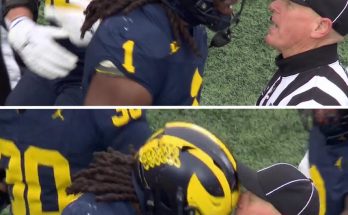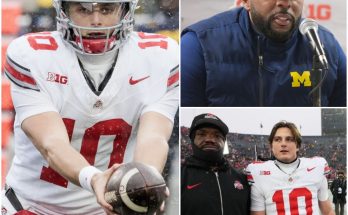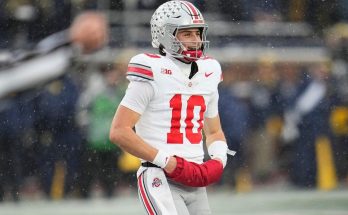As the 2025 college football season heats up, anticipation is growing not just for the thrilling matchups and high-stakes rivalries, but for one of the most coveted individual awards in sports: the Heisman Trophy. Year after year, the Heisman captivates fans and analysts alike, rewarding the player deemed the best in college football, and often serving as a launching pad for a successful NFL career. While the race is never truly predictable, certain players emerge as clear frontrunners based on their talent, production, team success, and media buzz. As of now, four athletes stand out as the most compelling candidates for the 2025 Heisman Trophy, each with unique skill sets, storylines, and the ability to etch their names into college football history.
At the top of the list is Caleb Williams, the quarterback sensation from the University of Southern California. Williams, who has already proven himself as one of the brightest young stars in the sport, continues to combine elite athleticism with a sharp football IQ. His ability to make plays both inside and outside the pocket sets him apart from most college quarterbacks, and his production has been nothing short of remarkable. In 2024, Williams displayed an uncanny ability to elevate his team in critical moments, leading USC to several come-from-behind victories and showcasing a poise beyond his years. The 2025 season represents an opportunity for Williams to solidify his legacy, not only by continuing his high level of performance but by leading USC deep into the College Football Playoff. He has the arm strength to make all the throws, the agility to escape pressure, and the competitive fire that makes Heisman voters take notice. His narrative is compelling: a young superstar poised to cement himself as one of the best quarterbacks in recent history, capable of transcending the college game. With USC’s schedule featuring several high-profile matchups against ranked opponents, Williams’ ability to shine under the brightest lights could be the deciding factor in his Heisman campaign.
Closely following Williams in the conversation is Marvin Harrison Jr., the dynamic wide receiver from Ohio State. Harrison Jr. represents a different type of Heisman contender: while quarterbacks often dominate the award, a wide receiver with his level of production, consistency, and playmaking ability can certainly capture the imagination of voters. Last season, Harrison Jr. was a touchdown machine, consistently stretching defenses and making seemingly impossible catches look routine. His route running, hands, and field awareness make him one of the most complete receivers in the nation. Beyond the numbers, Harrison Jr. has the intangible ability to change the momentum of a game with a single play. He can turn short gains into explosive touchdowns, force defenses to adjust schemes, and serve as the focal point of Ohio State’s offense. The Heisman has traditionally favored quarterbacks and running backs, but elite receivers who dominate games and produce highlight-reel moments are not overlooked. Harrison Jr.’s combination of size, speed, and technical skill makes him a legitimate contender, especially if Ohio State maintains a strong winning trajectory. The media love a compelling story, and Harrison Jr.’s rise as a generational talent in the Buckeye offense has all the elements of one.
The third frontrunner in the 2025 Heisman race is Bijan Robinson, the powerhouse running back from the University of Texas. Robinson is the embodiment of a traditional Heisman candidate: a running back with exceptional vision, balance, and explosiveness, capable of dominating games on the ground while also contributing in the passing game. Texas fans have watched Robinson carve up defenses with a rare combination of speed, power, and agility that allows him to turn broken plays into long touchdowns. His ability to carry the load for his team week after week makes him a natural candidate for the Heisman, as voters often reward consistent, game-changing production. While running backs face increasing scrutiny in the modern era of college football, where pass-heavy offenses dominate headlines, Robinson’s ability to produce eye-popping statistics and highlight-reel plays ensures that he cannot be ignored. If Texas maintains its competitiveness in the Big 12 and positions Robinson to pile up both yards and touchdowns, his Heisman candidacy will remain firmly in the conversation. Moreover, Robinson’s personality and presence off the field resonate with fans, giving him a marketable story that complements his on-field excellence. In an era where narrative plays a significant role in award voting, Robinson’s combination of dominance, charisma, and leadership makes him a legitimate contender.
Rounding out the top four is Drake Maye, the North Carolina quarterback whose ascent has captured national attention. Maye is the quintessential dual-threat quarterback, possessing both the arm talent to dissect defenses and the athleticism to extend plays with his legs. His performance in 2024 established him as one of the most prolific passers in college football, and heading into 2025, expectations are sky-high. Maye’s ability to read defenses, make quick decisions, and execute under pressure has made him a nightmare for opposing defenses. North Carolina’s offense is built around his talents, giving him the platform to post the kind of numbers that attract Heisman voters. Beyond statistics, Maye’s leadership and work ethic have earned him respect from teammates, coaches, and opponents alike, qualities that often influence voters in close races. If he can continue to elevate North Carolina on the national stage, particularly against ranked opponents, Maye’s candidacy will gain significant momentum. What makes Maye especially intriguing is his versatility: he is equally capable of winning a game through the air or on the ground, forcing defenses to account for every option. In a crowded Heisman field, that adaptability can be a deciding factor.
While these four players stand out as the frontrunners, the Heisman Trophy race is rarely straightforward. Injuries, team performance, and unexpected breakout players can quickly reshape the narrative. College football’s unpredictable nature ensures that the conversation will remain fluid throughout the season, with fans and analysts constantly weighing statistics, highlight plays, and storylines. One defining characteristic of a Heisman winner is the ability to deliver in high-pressure, nationally televised games, moments when the spotlight shines brightest. For Williams, Harrison Jr., Robinson, and Maye, these moments will be crucial in swaying voters and building a compelling case for the award. Each candidate brings a unique combination of skill, charisma, and opportunity, and their performances against top-tier competition will likely determine who ultimately claims the trophy.
Off-field narratives also play a significant role in shaping Heisman discussions. Williams’ continued development as a team leader and potential NFL prospect, Harrison Jr.’s journey to becoming a dominant receiving threat, Robinson’s pursuit of cementing his legacy as one of the most explosive backs in Texas history, and Maye’s effort to elevate North Carolina’s program all provide compelling stories that voters and the media gravitate toward. In many ways, the Heisman is as much about the story as it is about the stats, and these four candidates have narratives that resonate with fans, highlighting perseverance, leadership, and the pursuit of greatness.
Statistical dominance remains central to the Heisman conversation. Williams’ ability to produce high passing yardage, touchdowns, and key plays per game puts him in the upper echelon of quarterback talent. Harrison Jr.’s receiving totals, touchdown catches, and explosive plays have consistently kept him on the national radar. Robinson’s rushing totals, yards after contact, and ability to control the tempo of games make him a formidable force. Maye’s dual-threat numbers, including passing efficiency and rushing contributions, create a well-rounded statistical profile that appeals to Heisman voters. When combined with team success, these statistical achievements create a compelling argument for each player’s candidacy, and every week brings new opportunities to solidify or challenge their positions in the race.
Media coverage and fan engagement also play a subtle but important role in Heisman voting. Players who generate excitement and dominate highlight reels are more likely to stay at the forefront of voters’ minds. Williams’ ability to make jaw-dropping throws and extend plays will inevitably create memorable moments that circulate widely on social media and sports networks. Harrison Jr.’s spectacular catches and game-changing plays generate buzz that amplifies his visibility. Robinson’s breakaway runs and dynamic style of play ensure that he remains a fan favorite, while Maye’s versatile skill set creates highlight reels that emphasize his ability to take over games in multiple ways. In today’s media landscape, capturing attention is almost as important as dominating on the field, and all four candidates excel in this regard.
Another factor that can sway Heisman voters is a player’s performance in rivalry games and high-profile matchups. Games against traditional powerhouses, top-10 opponents, or in nationally televised spots provide players with the stage to demonstrate their ability to perform under pressure. Williams’ USC team has several marquee matchups that could define his season, offering him the opportunity to cement his status as the frontrunner. Harrison Jr. and Ohio State face a series of pivotal games that will test both his consistency and his ability to shine in the biggest moments. Robinson’s Texas squad also has high-stakes contests that could elevate his candidacy, while Maye’s leadership in challenging matchups will be crucial to North Carolina’s national relevance. These defining moments often separate Heisman winners from the rest of the field, and consistent performance in these contests is a hallmark of champions.
Injuries, of course, remain an unpredictable variable in any Heisman race. A single setback can dramatically alter the landscape, opening the door for other candidates or reshaping narratives entirely. While all four frontrunners have thus far remained healthy, the physical nature of college football makes durability an essential component of a winning campaign. Staying on the field, maintaining peak performance, and avoiding major injuries are critical factors that will influence both their statistical production and voter perception.
Team success also cannot be overlooked. The Heisman has historically favored players from winning programs, as team performance often magnifies individual accomplishments. Williams’ USC squad, Harrison Jr.’s Ohio State team, Robinson’s Texas team, and Maye’s North Carolina team all have the potential to compete at high levels nationally. A strong team record not only boosts a player’s visibility but also reinforces their contribution to the program’s overall success, a narrative that resonates with voters who want to recognize not only talent but also leadership and impact.
As the season progresses, the race is expected to intensify, with weekly performances, highlight plays, and emerging storylines constantly reshaping perceptions. While other players may certainly make their cases, Caleb Williams, Marvin Harrison Jr., Bijan Robinson, and Drake Maye represent the clearest frontrunners as of now. Their combination of elite talent, statistical dominance, team success, and compelling narratives ensures that they will remain central to every Heisman conversation throughout 2025. Fans can expect thrilling performances, unforgettable moments, and a season that will keep the Heisman race in the spotlight from start to finish.



